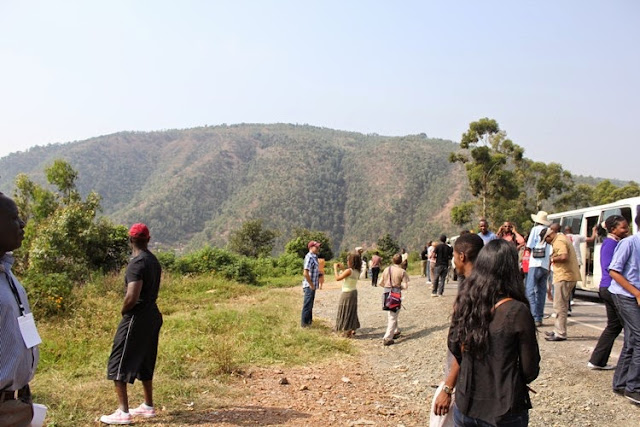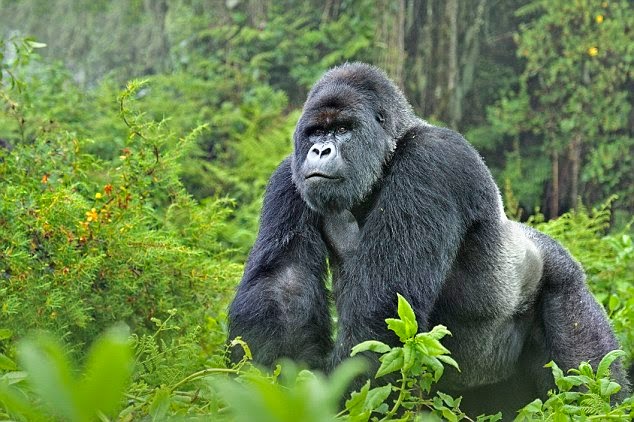Introduction
The name "gorilla" was derived from an ancient account by a
Carthaginian explorer who sailed along the west coast of Africa nearly 2,500
years ago. Local people shared their name for the great ape with him - the
rough translation of which meant "hairy
person".
The Mountain gorilla is one of the largest primates in the World with
the male mountain gorilla, known as a Silver-back, often growing to twice the
size of a female mountain gorilla. The Mountain gorilla has longer fur covering
its body when compared to other gorilla species, allowing them to be able to
withstand both hot and cold temperatures.
The Mountain Gorilla in The Volcanoes National park in Rwanda
Distribution
The mountain gorilla is one of the two subspecies of the eastern
gorilla. They are two populations; one is found in The Volcanic Mountains
of Central Africa, within three National parks: Mgahinga, in South-West of
Uganda; Volcanoes in North-West Rwanda; and Virunga in the Eastern Democratic
Republic of Congo (DRC).
Classification
The Mountain gorilla belongs to the Kingdom Animalia, Phylum Chordata,
Class Mammalia, Order Primates, Family Hominidae, Genus Gorilla, and Binomial
name: Gorilla Berengei Berengei.
Historically humans and their extinct ancestors were classified in the
Family Hominidae while all great apes (chimpanzees, bonobos, gorillas, and
orangutans) were classified in the Family Pongidae. However, bio-molecular and
genetic research along with recent fossil evidence have identified new
similarities between species, leading to the reclassification of chimpanzees
and gorillas into the Family Hominidae. The gorillas, are closely linked to
Human by DNA, gorillas are one of the four species of great apes that are the
closet living relatives of humans; like three others; Chimpanzees, bonobos and
orangutans,
In 2001 mitochondrial DNA research and morphological variances have led
to the scientific reclassification of gorillas. Under the new classification
gorillas are divided into two species, the eastern gorilla (Gorilla beringei)
and the western gorilla (Gorilla gorilla). It is thought that the two species
diverged from one another about 2 million years ago and both have two
subspecies.
The eastern gorilla's two subspecies are the eastern lowland gorilla
(Gorilla beringei graueri) and the mountain gorilla (Gorilla beringei beringei).
Due to the small size of mountain gorilla populations and
available samples for testing, it is difficult to determine whether the two
populations are physically and genetically distinct enough to be considered two
separate subspecies. The western gorilla's two subspecies are the western
lowland gorilla (Gorilla gorilla gorilla) and the Cross River gorilla (Gorilla
gorilla diehli).
Unique Features of the Mountain Gorilla
The Mountain gorilla is diurnal and spends most of its waking life
eating. Is highly sociable mammal and lives in groups of between 5 and 30
individuals, which includes mix of both male and female mountain gorillas. The
alpha male mountain gorilla tends to rule for around 5 years, and as these
mountain gorillas are non territorial.
The Mountain Gorilla live in groups of 5 to 30 individuals because they are very sociable
Mountain Gorilla is Omnivore and its favourite food is leaves, seed and
Herbs size: 1.5-1.8m, Weight: 204-227 kg, Top speed: 40km/h, Life Span: 35-50
years, Lifestyle: Social. Habitat: Tropical Forest and Jungles in Mountainous
regions. Average litter size: 1 baby. Predators: Human, Leopard. Special:
Sociable habits and agile hands and feet.
The scientific order Primates encompasses about 233 living species
classified in 13 scientific families. Most primates live in tropical forests
and vary greatly in size. The smallest primate member is the pygmy mouse lemur
weighing around 31 g, and the largest among the primate is Gorilla weighing
up to 220 kg.
Feeding behaviour
The Mountain gorillas have 32 teeth, the same in number as humans, they
have large strong teeth adapted for coarse vegetation they consume, adult male
develop big, sharp canines as they mature. They eat variety of plants;
favorites include wild celery, bamboo, thistles, stinging nettles, bed-straw and
certain fruits. These plants seem to provide sufficient moisture so that
gorillas do not need water.
Reproduction
The Mountain gorilla is highly social, and lives in relatively stable,
cohesive groups held together by long-term bonds between adult males and
Females. Relationships among females are relatively weak. These groups are non-territorial; the
silver-back generally defends the group rather than this territory for at least 5 years.
The Mountain gorilla mating is throughout the year, the gestation period
is 8.5 months with litter size of 1 baby, Gorilla infants are helpless at birth
and weigh about 3-4 Ibs. The Gorilla males are ready to mate when they are
approximately 15 years of age, for females it is about 8 years of age. Due to
the age maturity and how much time they give to their offspring, each female
may only have 3 to 4 of them in their lifetime.
Conclusion
American Zoologist Dian Fossey, the founder of Karisoke Research Center, an International Center for the study of Gorilla in Rwanda since 1967
The Mountain gorilla is a critically endangered
species, due to illegal activities such as poaching and Habitat loss. All these factors contributed in one way or another in endangering
the population of mountain gorilla. However
recent data shows that Mountain gorillas are experiencing a population
increase this is due to intensive conservation efforts and successful community
engagement in conservation process.
The views expressed are those of the author and not necessary of the Scientific studies






Comments
Post a Comment